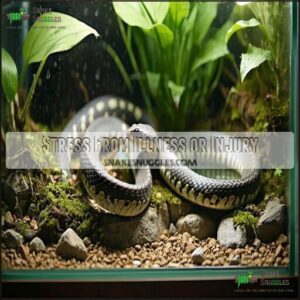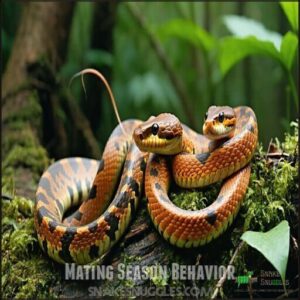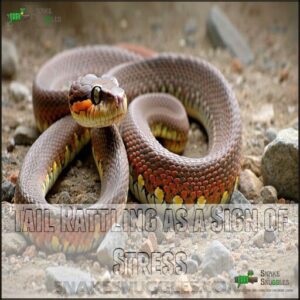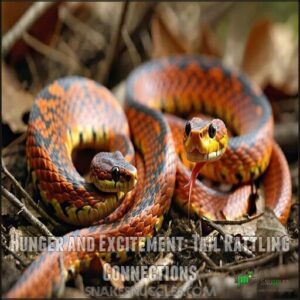This site is supported by our readers. We may earn a commission, at no cost to you, if you purchase through links.

By vibrating their tails against leaves or other surfaces, they imitate rattlesnakes, warning predators to back off.
This behavior, known as Batesian mimicry, makes them seem more dangerous than they actually are.
It’s a defense mechanism that works because predators don’t want to risk messing with a venomous snake.
They’ll also rattle if they feel scared, stressed, or cornered, even during handling or changes in their environment.
Think of it as their way of saying, “Give me space!”
Curious about what else their tail can tell you?
Keep reading to learn more about these fascinating creatures and their defense mechanism.
Table Of Contents
- Key Takeaways
- The Purpose of Tail Rattling in Corn Snakes
- Corn Snake Tail Rattling Vs. Rattlesnake Rattling
- Common Triggers for Corn Snake Tail Rattling
- Tail Rattling as a Sign of Stress
- Hunger and Excitement: Tail Rattling Connections
- Tail Rattling in Wild Vs. Captive Corn Snakes
- Interpreting Body Language Alongside Tail Rattling
- Age and Gender Factors in Tail Rattling
- Addressing and Preventing Excessive Tail Rattling
- Tail Rattling Myths and Misconceptions Debunked
- Frequently Asked Questions (FAQs)
- Why does a corn snake make a rattling noise?
- Do rattlesnakes shake their tails?
- Do snakes Rattle Their tails?
- Why do colubrid snakes Rattle Their tails?
- Why does my pet snake vibrate its tail like a rattlesnake?
- What snakes don’t have a rattlesnake?
- Why is my corn snake rattling his tail?
- Why does my snake shake his tail?
- Why do snakes rattle their tails?
- What makes a corn snake happy?
- Conclusion
Key Takeaways
- Corn snakes rattle their tails to mimic rattlesnakes, scaring off predators through Batesian mimicry—a brilliant survival strategy.
- They rattle as a response to stress, fear, or environmental triggers like sudden changes, handling, or loud noises.
- Tail rattling isn’t aggression; it’s a defense mechanism signaling discomfort or unease, so always pay attention to their body language.
- A calm, enriched environment with proper handling reduces stress and helps prevent excessive tail rattling in captive snakes, promoting a brilliant survival strategy.
The Purpose of Tail Rattling in Corn Snakes
When a corn snake rattles its tail, it’s not just random movement—it’s a carefully evolved survival tactic.
This behavior helps them mimic venomous rattlesnakes, scare off predators, and even communicate with other snakes.
Defense Mechanism Against Predators
When a predator approaches, corn snakes rely on a clever snake defense mechanism to stay safe.
Corn snakes bluff brilliantly, rattling their tails to mimic venomous rattlesnakes and scare off predators, turning fear into freedom.
They use Batesian mimicry, a survival trick where harmless species imitate dangerous ones, to confuse predators and buy time to escape. Their tail rattling mimics venomous rattlesnakes, creating a sound that screams “back off!”
Here’s their three-step bluffing behavior:
- Rattle the tail: Vibrate it rapidly against leaves or debris to produce a threatening noise.
- Defensive posture: Coil up and appear larger, adding to the illusion.
- Quick warning strikes: Non-venomous but intimidating enough to cause predator confusion.
This survival advantage is all about turning fear into freedom.
Mimicking Rattlesnakes for Survival
You witness a clever survival tactic when corn snakes rattle their tails, mimicking rattlesnakes through Batesian mimicry. This evolutionary advantage provides predator deterrence, as the snake’s tail vibration creates a defensive bluffing mechanism.
By vibrating its tail, the corn snake appears more threatening, showcasing its survival adaptation. This behavior is a key aspect of corn snake behavior, utilizing snake tail rattling to deceive potential threats.
This behavior highlights the importance of Batesian mimicry in the snake’s defense mechanism, allowing it to thrive without venomous capabilities.
Communication With Other Snakes
You’ll discover corn snakes use a sophisticated communication system, including vibration signals, pheromone exchanges, and tail rattling cues.
They convey:
- Mating signals
- Social hierarchy
- Territory warnings through chemical communication and vibration signals, showcasing complex reptile communication and snake behavior in snake tail rattling and snake vibrations.
Territorial Behavior and Warnings
You’ll notice corn snakes rattle their tails to defend territory.
This behavior, known as Territory Defense, involves Warning Signals to deter encroachment.
Key aspects include:
- Spatial Awareness
- Dominance Displays
- Encroachment Responses
- Reptile communication
- Snake tail rattling
They use snake tail rattling to warn others.
Corn Snake Tail Rattling Vs. Rattlesnake Rattling
In the context of snake tail rattling, you’ll find corn snakes and rattlesnakes have different strategies. It’s like comparing a gentle hum to a loud, clear warning.
| Feature | Corn Snake | Rattlesnake |
|---|
————-:
————-:
Corn snake tail rattling isn’t the same as a rattlesnake’s. The vibration frequency is lower, and they lack keratin segments. It’s all about mimicry effectiveness.
Rattlesnakes use their rattles as a genuine warning, while corn snakes bluff. This snake tail rattling behavior is an evolutionary advantage. The difference in strategy is crucial for understanding the distinct purposes of each snake’s behavior.
Common Triggers for Corn Snake Tail Rattling
You’ll notice that corn snakes rattle their tails in response to various triggers, including perceived threats, handling, and changes in their environment.
As you observe your corn snake’s behavior, you’ll find that it may rattle its tail due to stress, illness, or even mating season, highlighting the complexity of this fascinating survival behavior.
Perceived Threats in The Environment
When your corn snake feels threatened, it’s all about environmental fears. Understanding what triggers their defense mechanism helps you recognize danger signs.
Tail rattling is a key part of their survival strategy. It’s a form of Batesian mimicry, where they imitate rattlesnakes.
Here’s what might set off that snake tail vibration:
- Unfamiliar objects in their space
- Sudden noise pollution
- Predator proximity
- Unexpected habitat changes
These stress triggers activate their predator avoidance instincts. Visual stimuli, like a looming hand, can also cause alarm. Even inadequate enclosure size can contribute to snake tail rattling, impacting corn snake behavior.
Handling and Human Interaction
When handling your snake, a calm touch is key. Sudden movements can trigger defensive tail rattling, a sign of corn snake stress.
Focus on gentle handling—move slowly and keep interactions predictable. Speak softly, approach with patience, and respect its body language.
Building trust and minimizing rattling takes time, but safe interaction guarantees your pet feels secure. Regular handling, about one to two times a week, helps them become more docile.
Reduce stress by keeping sessions short and steady. It’s all about fostering confidence, not fear.
Changes in Habitat or Enclosure
Changing up your snake’s enclosure can turn their world upside down. Whether it’s New Enclosure Stress, swapping substrates, or rearranging décor, these shifts can make your snake feel like a visitor in their own home.
Tail rattling often kicks in as they adjust to unfamiliar surroundings. Help them settle by introducing changes gradually and keeping handling post-change to a minimum.
A Behavioral Observation Log is handy for spotting stress signals. By respecting their habitat, you’ll ease Territory Readjustment and foster calm corn snake behavior.
Adequate space is essential; consider appropriate enclosure products for their well-being, ensuring a comfortable environment that supports their overall health.
Stress From Illness or Injury
Stress from illness or injury can turn your corn snake’s tail rattling into a clear distress signal.
It’s often paired with warning signs like unusual breathing or lethargy.
Here’s how to spot potential problems:
- Illness Indicators: Reduced appetite or erratic movements.
- Injury Impact: Visible cuts, bruising, or swelling.
- Pain Response: Consistent tail rattling during handling.
- Veterinary Care: Seek help for respiratory infections or mouth rot.
- Stress Prevention: Maintain ideal temperature, space, and quiet surroundings.
Early recognition keeps your snake’s health in check, ensuring they thrive stress-free.
Mating Season Behavior
During mating season, a corn snake’s tail isn’t just for balance—it’s a major player in courtship rituals.
Pheromone signals and hormonal surges bring about fascinating snake behavior, including tail rattling.
Males use this as part of their mating rituals to establish dominance, attract females, and signal readiness to breed.
- This behavior, intertwined with nesting behavior and breeding success, highlights snake communication as more than instinct—it’s strategy.
Tail rattling becomes their way of broadcasting intentions across the reptilian dating world, showcasing a unique form of reptilian communication.
Tail Rattling as a Sign of Stress
When a corn snake is stressed, it may rattle its tail as a defensive warning, signaling discomfort or unease.
This behavior is often triggered by factors like unsuitable environments, sudden changes, or improper handling.
Environmental Factors Causing Stress
Noise, lighting, and other environmental triggers can easily disrupt your corn snake’s comfort, causing stress and defensive behaviors like snake tail rattling.
Factors like inappropriate habitat size or unstable temperature gradients can make your snake feel uneasy. Harsh lighting conditions and fluctuating humidity levels may further agitate them, leading to heightened defensive reactions.
Keep the enclosure’s temperature stable between 75-85°F with proper humidity levels around 40-60%.
Use soft, indirect lighting and maintain enclosure cleanliness to maintain healthy behavior. By minimizing stressors, you’ll help your snake feel safe and prevent unnecessary tail-rattling episodes rooted in environmental discomfort.
Reducing Stress in Captive Corn Snakes
A calm corn snake starts with a stress-free home.
If tail rattling crops up, it could signal the need for adjustments in their environment or care.
Here’s how to reduce stress effectively:
- Create Secure Hideouts: Confirm hide availability by adding snug, natural hiding spots where your snake can retreat when overwhelmed.
- Master Gentle Handling: Support their entire body, move slowly, and avoid pressuring them, especially during shedding or after meals.
- Optimize Enclosure Enrichment: Add climbing branches, varied terrain, and explore zones for natural behaviors.
Minimize tail rattling by focusing on proper temperature control, enriching the enclosure, and respecting corn snake behavior cues.
Stressed snakes may exhibit increased hissing or striking, indicating discomfort.
Long-Term Effects of Chronic Stress
Over time, chronic stress dramatically impacts your corn snake’s behavior, health, and lifespan.
Constant stress wears them down, leading to immune suppression, growth inhibition, and even reproductive issues. Frequent tail rattling, defensive posturing, or hiding too often could indicate underlying stress.
Here’s how stress influences their overall well-being:
| Behavioral Changes | Physical Impact | Long-Term Effects |
|---|---|---|
| Excessive Hiding | Compromised Immunity | Shortened Lifespan |
| Snake Tail Rattling | Hormonal Disruption | Breeding Problems |
| Decreased Appetite | Slowed Growth | Weakened Health |
| Agitation | Metabolic Issues | Higher Illness Risk |
| Defensive Posturing | Nervous System Strain | Delayed Recovery |
By creating a stable, low-stress environment, you can prevent these issues.
Focus on proper handling, ideal habitat conditions, and consistent care to promote healthier corn snake behavior.
Hunger and Excitement: Tail Rattling Connections
You might notice your corn snake rattling its tail when it’s hungry or excited, signaling heightened energy and anticipation.
Understanding this behavior can help you distinguish hunger from other triggers and adjust feeding routines to keep your snake healthy.
Pre-Feeding Behavior Patterns
When it’s mealtime, your corn snake’s tail rattling shows off its incredible hunting anticipation. This behavior isn’t just noise—it’s instinct in action.
Look for these telltale signs during prey stalking rituals:
- Intense tail vibration as excitement builds.
- Rapid tongue flicking, collecting scent clues.
- Muscle coiling and focused body tension, ready to strike.
- Focused gaze, locking onto prey targets.
- Glass-directed strikes, rehearsing for the real hunt.
These actions reveal your snake’s natural strike preparation and corn snake behavior in its purest form.
Snakes also use chemical signals and pheromones for communication.
Distinguishing Hunger From Other Triggers
Figuring out if your corn snake is hungry or stressed can feel like solving a riddle. Tail rattling has different meanings, depending on the context.
When hunger drives the behavior, expect these signs:
- Feeding cues like tongue flicking and focused movement.
- A softer tail rattle showing excitement and anticipation behavior.
- A calm, curious posture during meal timing.
In contrast, stress rattling often pairs with defensive behavior—like tense, coiled positions, or rapid rattling. Stress signals show discomfort or fear, while hunger-related snake communication is more energetic and deliberate. Watching for body language clues can help you separate a need for food from environmental discomfort or feelings of threat.
Adjusting Feeding Schedules to Reduce Rattling
When your corn snake’s tail rattling hints at hunger, adjusting the feeding frequency and sticking to a consistent schedule can help.
Choose the right prey size, ensuring it’s neither too big nor too small, and maintain a predictable feeding routine.
Pay attention to your snake’s behavior—a calm dining environment reduces stress. By tracking patterns and adding diet variety, you create a less stressful mealtime and minimize unnecessary tail-shaking behavior.
Overfeeding and Its Impact on Behavior
A corn snake’s health depends on feeding the right portions, as overfeeding can lead to obesity effects, regurgitation risks, and temperament changes.
Large meals disrupt digestion, reducing activity and triggering defensive behavior like tail rattling.
- Feed prey no wider than 1.5 times your snake’s body width.
- Stick to regular schedules for balance.
- Avoid excessive treats.
- Watch for reduced activity or regurgitation.
- Monitor weight to prevent lifespan impacts and ensure a healthy snake by maintaining the right feeding balance.
Tail Rattling in Wild Vs. Captive Corn Snakes
You’ll notice that wild corn snakes rattle their tails more frequently, often in response to predators or sudden environmental threats.
In captivity, this behavior is less common, as controlled environments reduce the need for such defensive displays.
Natural Habitat Influences on Behavior
Corn snakes are nature’s survival artists, honing behaviors like tail rattling to navigate their challenging wild habitats.
Tail rattling is a masterful bluff, turning harmless corn snakes into survival experts in the face of predators.
Their lives are shaped by key factors such as prey availability, predator density, and habitat complexity. Snake tail rattling acts as a Batesian mimicry defense mechanism, fooling predators into thinking the harmless corn snake is venomous.
Here’s how their behavior aligns with their surroundings:
| Trigger | Behavioral Response | Purpose |
|---|---|---|
| Predator encounters | Tail rattling, hiding | Defense via deception |
| Temperature shifts | Basking or burrowing | Temperature regulation |
| Seasonal changes | Adjusting activity levels | Energy conservation |
From rocky terrains to forest edges, corn snakes master adaptive survival, balancing predator evasion with temperature regulation, proving how their snake habitat shapes their clever strategies.
Adapting to Captivity and Behavioral Changes
When moving from the wild to captivity, corn snakes undergo interesting changes in behavior, particularly with tail rattling, a classic defense mechanism.
In the wild, unpredictable threats keep them on edge, but in captivity, stress gradually eases as their environment becomes secure and predictable.
To understand this shift, here’s a quick comparison:
| Aspect | Wild Setting | Captive Life |
|---|---|---|
| Stressors | Daily predator threats | Managed stress triggers |
| Behavior | Constant vigilance | Reduced defensive alerts |
| Interaction | Minimal human exposure | Trust built over time |
Providing hiding spaces, stable temperatures, and enrichment strategies, like climbing structures, helps reduce stress and limits tail rattling.
Gentle handling impacts behavior positively, promoting trust and calmness.
With patience, your snake adapts to this new lifestyle, shifting from wary traditional behavior to a relaxed, communicative companion.
Frequency of Tail Rattling in Different Settings
In different settings, snake tail rattling highlights fascinating behaviors influenced by habitat frequency, age, and threat level.
Wild snakes rattle more often due to predators, while captive ones show variability based on handling stress and environmental changes.
Seasonal patterns also impact snake behavior, emphasizing context-driven rattling frequency.
| Environment | Trigger | Frequency |
|---|---|---|
| Wild | Predator Threats | High |
| Captive | Handling Stress | Low to Moderate |
| Mixed Environments | Environmental Changes | Variable |
| Controlled Habitat | Minimal Threats | Minimal |
The table summarizes the rattling frequency of snakes in different environments, triggered by various factors such as environmental changes and handling stress.
Conservation Implications of Behavioral Differences
Understanding tail rattling highlights critical conservation factors like habitat loss and snake communication.
Wild corn snakes rely on Batesian mimicry for defense, while captives adapt behaviors to controlled environments. Behavioral adaptations in captivity show reduced mimicry success, potentially affecting conservation efforts.
Captive breeding programs must prioritize snake defense mechanisms while maintaining genetic diversity.
| Aspect | Wild Corn Snakes | Captive Corn Snakes |
|---|---|---|
| Tail Rattling Use | Predator Defense | Stress Response |
| Behavioral Complexity | High | Moderate |
| Mimicry Success | Effective | Reduced |
| Snake Communication | Essential for Survival | Limited |
| Conservation Impact | Fundamental to Ecosystem Balance | Dependent on Care Practices |
Interpreting Body Language Alongside Tail Rattling
When a corn snake rattles its tail, its body language provides important context about its intentions and emotional state.
By watching for signs like posture, head movement, and tongue flicking, you can better understand what the snake is trying to communicate, using body language to grasp its intentions.
S-Shaped Posture and Defensive Strikes
When your snake forms an S-shape, it’s not just lounging—it’s prepping for action.
This defensive posture is a classic defense mechanism signaling, “Stay back!” It combines precision strikes with intimidation, backed by effective snake communication.
Here’s how it works:
- Tightly coiled S-shape: Maximizes strike speed and agility.
- Head pulled back: Ready for an accurate strike within its range.
- Tail rattling: Enhanced by Batesian mimicry, mimicking rattlesnakes.
- Tense muscles: Essential for muscular mechanics and quick reactions.
This defensive strategy guarantees survival by blending strength and strategy, a hallmark of nature’s finest.
Head Position and Eye Movement
Your corn snake’s head and eyes offer fascinating insight into its mood and behavior. A calm snake shows smooth head movements, exploring its surroundings with gentle curiosity.
Conversely, if it feels threatened, its head becomes stiff, movements turn abrupt, and its gaze sharpens—like a laser focusing on potential danger. Pupil dilation marks heightened awareness, signaling the snake’s threat assessment is kicking in.
These visual cues are part of complex sensory integration, helping with strike accuracy and depth perception in both defensive mechanisms and hunting vision. By observing these subtle shifts, you can better understand your snake’s communication and spot the triggers behind behaviors like tail vibration or defensive displays.
Muscle Tension and Overall Body Posture
Pay attention to a corn snake’s muscle stiffness and posture changes—they’re like a warning sign.
A tense, coiled body with movement restriction signals fear or readiness to defend itself, often paired with tail vibration.
On the flip side, a relaxed snake shows fluid body alignment and calmness.
These tension indicators help decode their defense mechanism, as every quiver or shift reveals their instincts.
Watch closely; their snake tail shaking speaks volumes.
Tongue Flicking Frequency and Meaning
When your corn snake flicks its tongue, it’s like it’s taking a quick sniff of the world, decoding everything around it.
This flicking rate offers a window into its mood and environment through chemical reception and sensory input.
- Slow flicks: Relaxed mood, no threats.
- Rapid flicks: High alert or stress.
- Absent flicks: Resting or disinterested.
These tongue movements help with prey detection and environmental analysis, acting as its natural radar.
By observing this snake behavior, you’ll grasp its communication signals and behaviors more clearly, improving your bond.
Age and Gender Factors in Tail Rattling
You’ll notice that a corn snake’s age and gender can influence how often or why it rattles its tail.
Juvenile snakes tend to rattle more frequently than adults, while males and females may show subtle differences depending on the situation.
Juvenile Corn Snake Behavior Patterns
Juvenile corn snakes, fresh to the world, rely heavily on their early learning and socialization needs to navigate their surroundings.
Their growth stages are marked by heightened predatory instincts, and tail rattling becomes a key defense mechanism. These young snakes use tail vibrations to mimic rattlesnakes, scaring off potential threats or perceived predators.
When startled or feeling vulnerable, they rapidly rattle their tails, often brushing against leaves or surfaces, amplifying the sound. This snake behavior stems from their built-in need for survival in environments they’re still exploring.
Handling impacts can either soothe or intensify their reactions—so always approach gently and at their comfort levels. Providing a secure habitat encourages calmness and reduces overstimulated responses in these developing reptiles.
Adult Male Vs. Female Rattling Differences
Male and female corn snakes show fascinating differences in tail rattling behavior.
Hormonal influence plays a big role—males rattle their tails aggressively during mating displays, often to establish dominance.
Females, on the other hand, use gentler tail vibrations to signal distress or defend against threats.
Here’s a quick breakdown:
- Males show higher aggression levels, especially during breeding.
- Females protect offspring with subtle defensive rattling.
- Size correlation affects sound: longer male tails amplify vibrations.
- Frequency variation peaks during mating season for males.
This reveals their nuanced communication strategies and highlights the importance of understanding these behaviors, including hormonal influence and defensive rattling, in the context of breeding.
Seasonal Variations in Tail Rattling Frequency
Seasonal variations bring fascinating changes to snake behavior, like tail rattling in corn snakes.
During the mating season, hormonal shifts heighten snake rattling frequency, especially in territorial males.
Cooler months and brumation effects may lower activity but increase defensive tail vibrations when snakes feel threatened.
Warmer temperatures and higher prey availability in spring and summer lead to frequent rattling, signaling alertness to environmental triggers.
Humidity impacts also play a role, as seasonal dryness or moisture affects snakes’ comfort levels, and understanding how temperature influence and humidity impact seasonal snake behavior helps you spot patterns in your pet’s rattling and responses.
Behavioral Changes Throughout Lifespan
From birth to their golden years, corn snakes showcase fascinating shifts in their snake behavior development.
Tail rattling evolves across their lifespan, reflecting their learning curve and growing adaptability.
- Juvenile Behavior: Young corn snakes often rely on constant tail vibration to mimic rattlesnakes, warding off predators.
- Adult Changes: With age, they embrace a more refined approach, reserving snake tail shaking behavior for serious threats.
- Aging Effects: Older snakes conserve energy, rattling sparingly yet effectively when absolutely necessary.
- Behavioral Maturation: While young snakes may react instinctively, adults calculate their movements, blending experience with environment.
Each life stage highlights nature’s brilliant blueprint, as corn snakes adapt their defensive tools for survival in a constantly changing world.
Addressing and Preventing Excessive Tail Rattling
If your corn snake rattles its tail excessively, it’s often a signal that something in its environment or care isn’t quite right.
By understanding the causes and making adjustments, you can help your snake feel secure and reduce this defensive behavior.
Creating a Stress-Free Environment
A stress-free habitat is key to minimizing your corn snake’s tail-rattling behavior. Start with a well-designed enclosure that includes secure hideouts for safety and shaded spots for relaxation.
Temperature control is essential; maintain a gradient between 75-85°F to regulate their metabolism. Habitat enrichment, like climbing branches and textured decor, engages natural snake instincts and prevents boredom.
Keep the environment calm by avoiding loud noises or sudden movements. Always observe behavior for signs of stress, like excessive tail rattling, to adjust conditions as needed.
A key element of their habitat is providing a secure snake hide to reduce stress. Thoughtful handling, paired with proper feeding and enrichment, creates a serene home encouraging healthy, natural snake behavior.
Proper Handling Techniques to Minimize Rattling
Handling corn snakes takes patience and a thoughtful touch. After creating a calm habitat, focus on how you interact. A gentle approach paired with slow movements can ease their defensive behavior, like tail vibration. Always provide a secure grip, supporting the snake’s entire body, not just part of it. Quick motions or grabbing their tail can easily cause stress.
If you’re nervous, consider using specialized protective gear for added safety.
Pay attention to their body language. If the snake coils or rattles its tail, it’s a clear "back off" signal.
Here’s how to handle them effectively:
- **Approach from the side.
- **Use slow, predictable movements.
- **Support as much of their body as possible.
- **Limit handling to calm moments.
- **Respect defensive signals.
Patience builds trust—and confidence reduces rattling.
Enrichment Activities to Reduce Defensive Behaviors
To ease defensive behaviors like tail rattling, focus on creative enrichment activities that keep your corn snake calm and curious.
Start by adding habitat complexity with climbing branches, varied hiding spots, and novel objects to explore.
Include foraging opportunities by scattering safe treats or scented items for your snake to find.
Enhance sensory stimulation by rotating habitat decor or using substrates with different textures.
A great way to encourage exploration is to provide varied hiding places.
These activities mimic natural settings, encouraging healthy animal behavior while minimizing stress-induced reactions like snake tail vibration or other defensive displays.
When to Seek Veterinary Assistance
If enrichment ideas aren’t reducing your corn snake’s rattling, it could hint at health issues needing attention.
Behavior changes—like increased rattling—are your snake’s way of saying, “Something’s off.”
Look for these signs:
- Rattling frequency change paired with visible injuries or abnormal shedding.
- Appetite loss, sudden weight changes, or lethargic behavior.
- Breathing like there’s a whispering breeze.
- Skin rougher than sandpaper.
If rattling persists or you spot these clues, it’s time for a trip to the veterinarian.
Early checks can rule out infections, stress, or unseen injuries.
Your corn snake depends on you to notice what doesn’t feel right—it’s their only way of “talking” to you.
Tail Rattling Myths and Misconceptions Debunked
You might think a rattling tail means a corn snake is aggressive, but that’s a common misconception.
Understanding the myths about this behavior can help you recognize it as a clever survival tactic, not a sign of hostility.
Common Misinterpretations of Corn Snake Behavior
Corn snake tail rattling often sparks myths, yet it’s rarely about aggression vs. defense. They rattle to mimic rattlesnakes, a defense mechanism to deter threats.
Many assume angry intent, but it’s usually stress-induced behavior.
| Myth | Reality |
|---|---|
| Snakes are aggressive | Rattling shows fear, not anger. |
| Tail movement is random | It’s intentional snake mimicry. |
| Snakes lack intelligence | Tail rattling reflects adaptability. |
Observe triggers like habitat changes to better understand this snake tail vibration.
Distinguishing Aggression From Defense Mechanisms
Snake tail rattling is more about survival smarts than aggression.
It’s a defense mechanism screaming, "Stay back!" rather than a fight invitation.
Notice behavioral cues like loose coils or slow movements—they’re not attacking but evaluating threats.
Aggressive actions, such as tense muscles or direct strikes, are very different.
This defensive continuum makes tail vibrations an Intent vs. Action strategy.
Through mimicry deception, they confuse predators, making snake defense all about evasion, not confrontation.
Respect their boundaries, and you’ll avoid misunderstandings.
Cultural Beliefs About Snake Tail Rattling
Why does snake tail vibration stir so many cultural beliefs? For centuries, rattling tails have been cloaked in mystery, often misinterpreted in fascinating ways.
- Snake folklore often portrayed tail vibrations as divine warnings, signaling danger or supernatural power.
- Many Indigenous beliefs tied the sound to protection or an omen of conflict, influenced by symbolic meanings.
- Religious interpretations viewed rattling as aggression, linked with serpentine deities or omens.
In reality, this behavior is Batesian mimicry—a clever defense mechanism.
By mimicking rattlesnakes, corn snakes trick predators into thinking they’re dangerous.
It’s survival, not mysticism, driving this mesmerizing snake behavior.
Scientific Research on Corn Snake Communication
You might think a tail rattle is just noise, but corn snakes use it as part of a brilliant snake survival strategy.
Research reveals their snake tail vibration acts as a warning, showcasing nature’s clever design. It’s more than sound—it’s snake communication in action.
By mimicking rattlesnakes, corn snakes employ vibration signals that confuse predators and buy escape time. Some studies even suggest tail rattling mixes with pheromone communication to establish a social hierarchy or convey intentions during interactions.
These behavioral insights highlight how snake defensive mechanisms go beyond instinct, proving their intelligence through innovative survival and social tactics.
Frequently Asked Questions (FAQs)
Why does a corn snake make a rattling noise?
Imagine this scenario: a snake doing its best rattlesnake impersonation.
Corn snakes rattle their tails to scare off predators, using vibrations against leaves or surfaces to mimic danger.
It’s bluffing, not biting—a clever, instinctive defense!
Do rattlesnakes shake their tails?
Yes, they do! Rattlesnakes rapidly vibrate their tails, creating that iconic buzzing sound.
Those special keratin segments in their rattles click together, warning predators, “Back off!”
It’s nature’s clever alarm system, and it works brilliantly.
Do snakes Rattle Their tails?
Some snakes, like rattlesnakes and corn snakes, rattle their tails as a defense mechanism.
It’s their way of saying, “Back off!” while mimicking danger, startling predators, or warning others to stay clear of their space.
Why do colubrid snakes Rattle Their tails?
Colubrid snakes rattle their tails to mimic venomous species, like rattlesnakes, as a defense.
It startles predators, creates a threatening sound, and gives the snake a chance to escape—nature’s clever bluff in action!
Why does my pet snake vibrate its tail like a rattlesnake?
It’s like your snake’s way of bluffing during a poker game—it’s scared or stressed.
Tail vibrations mimic rattlesnakes, warning threats, including you, to back off.
Check their environment, handling, and health for triggers.
What snakes don’t have a rattlesnake?
Not every snake sports a built-in rattle.
Corn snakes, garter snakes, and king snakes rattle their tails against surfaces to mimic rattlesnakes, bluffing predators.
Smooth operators like pythons skip the noise altogether, relying on strength instead.
Why is my corn snake rattling his tail?
Imagine your snake’s tail as an alarm clock.
Your corn snake rattles its tail because it feels threatened, stressed, or startled.
Check its environment, handling, and health to address potential triggers and reduce discomfort.
Why does my snake shake his tail?
Your snake shakes its tail as a defense mechanism when it feels threatened or stressed.
It’s their way of mimicking a rattlesnake to deter predators.
Check their environment for stressors or discomfort triggers.
Why do snakes rattle their tails?
Snakes rattle their tails as a defense mechanism to scare off predators.
It’s like saying, “Back off!”
Some mimic rattlesnakes by vibrating tails against leaves or debris, using sound to bluff and escape danger.
What makes a corn snake happy?
Did you know a corn snake thrives at 75-85°F with 40-60% humidity?
Give yours a cozy habitat with hiding spots, gentle handling, and regular meals.
A relaxed, enriched environment keeps them happy and healthy.
Conclusion
Imagine handling a corn snake, and it suddenly rattles its tail against the enclosure floor.
It’s not aggression—it’s a clever defense strategy. Corn snakes rattle their tails to mimic rattlesnakes, scaring off predators or signaling stress.
This fascinating behavior reveals their adaptability in the wild and in captivity. By understanding why corn snakes rattle their tails, you can better interpret their body language, reduce stress triggers, and guarantee they thrive in a safe, peaceful environment.



















